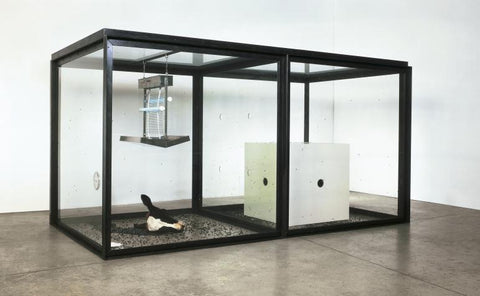Back in 1994, art duo and KLF musicians, Jimmy Cauty and Bill Drummond famously travelled to the Scottish island of Jura, and in one of the most shocking and divisive instances of performance art on record, burned one million pounds in cash. The burn, which took just one hour, baffled and infuriated the nation.
Ever contentious, and known for acts of spectacle, it’s no real surprise that Damien Hirst is now treading a similar path. On September 9th, The Currency launches at London’s Newport Street Gallery, and it promises to be the controversial artist’s most flammable show to date.

Damien Hirst with The Currency artworks, 2021. Photographed by Prudence Cuming Associates Ltd © Damien Hirst and Science Ltd, DACS 2021.
In today's art blog, we're providing some background on The Currency and listing Hirst's Top 5 Most Shocking Moments...
The Currency
The Currency is Hirst’s first foray into the world of NFTs. The project consists of 10,000 of the artist’s iconic spot paintings, each with a corresponding NFT. So far, so normal, right? Wrong.
Hirst’s experiment is an “exploration of the boundaries of art and currency – when art changes and becomes currency, and when currency becomes art.”
So, here’s the kicker… those who bought the artworks had one year to decide whether they wanted the physical piece or the digital piece. The one they decided against would be permanently destroyed.
By asking buyers to decide between the physical and digital versions, Hirst has made them part of the exhibition – effectively asking them to take a chance, and decide which one they think has more lasting value.
As the deadline loomed, debate raged over the merits of the two mediums, with those leaning towards NFTs stating they are “much faster and easier to sell” and that if they destroy the NFT they could regret it later, and those leaning towards the physical copies expressing concern over the volatility of the NFT and crypto markets, and stating “nobody knows yet whether NFTs are a fad” – which we suspect is entirely the point.
The final vote
“I have been all over the shop with my decision making, trying to work out what I should do. In the beginning I thought I would choose all physical. Then I thought half and half, and then I flit to keeping all of my 1,000 as NFTs, then all paper again, and round and round I’ve gone.”
The exhibition begins on September 9th 2022 at London’s Newport Street Gallery. Hirst will be burning art at a designated time every day, culminating in a mass burn as part of Frieze Week in October.
5 times Damien Hirst shocked the world
"It's amazing what you can do with an 'E' in A-Level art, a twisted imagination and a chainsaw." Damien Hirst
Over the years, Hirst has infuriated, repulsed and shocked the world with his grotesque artworks and blatant intent to capitalise on his art. Here, we list five of his most shocking moments…
1 - A Thousand Years (1990)
(Photo: Roger Wooldridge)
One of Hirst’s first animal installations was A Thousand Years – a macabre offering consisting of a large glass case containing maggots and flies feeding on a decapitated and rotting cow’s head.
This was the piece that bought Hirst to the attention of Charles Saatchi who apparently, ‘stood open-mouthed with astonishment as he viewed the work. After seeing the piece, Saatchi offered to fund whatever artwork Hirst wanted to make.
With £50,000 of Saatchi’s funding in his pocket, Hirst created what is perhaps his most infamous piece – The Physical Impossibility of Death in the Mind of Someone Living (1991) - a 14ft tiger shark suspended in formaldehyde.
2 - With Dead Head (1991)

(Photo copyright: Damien Hirst and Science Ltd)
Growing up in Leeds, and again when studying at Goldsmith’s, Hirst took part-time jobs working in mortuaries, where he would regularly sketch the dead bodies. It is these jobs that Hirst credits with developing the fascination with death that we see across his oeuvre.
With Dead Head is a photograph of a young Hirst, grinning while posing next to a decapitated head. The work sparked fright and disgust, with many deeming it disrespectful of the dead.
3 - Two Fucking and Two Watching (1995)
In the year that Hirst first won the Turner Prize, his work Two Fucking and Two Watching, which featured a rotting cow and bull, was banned from a New York museum by public health officials because of ‘vomiting among visitors’.
Perhaps its gruesomeness explains why it's so difficult to find a photograph of the piece...
4 - For the Love of God (2007)

(Photo: Reuters)
When Hirst encrusted a real human skull with 8,601 diamonds, and slapped on a £50m price tag, For the Love of God was quickly deemed a ‘vulgar publicity stunt’. Undeterred, the following year Hirst released For Heaven’s Sake which was cast from an infant’s skull, and covered with pink and white diamonds. The piece enraged parenting groups who argued the artwork was deeply insensitive to those who had suffered the loss of a child.
5 – The Miraculous Journey (2018)

The Miraculous Journey is a series of enormous sculptures charting the voyage from conception to birth erected outside a women’s hospital in Doha, Qatar. Originally unveiled in 2013, the sculptures were quickly covered from public view following widespread outcry over Hirst’s graphic depiction of sperm fertilising an egg. The sculptures were reopened in 2018, and have gone down in history as the first naked sculptures in the Middle East.
Explore our collection of limited edition artworks by Damien Hirst.




